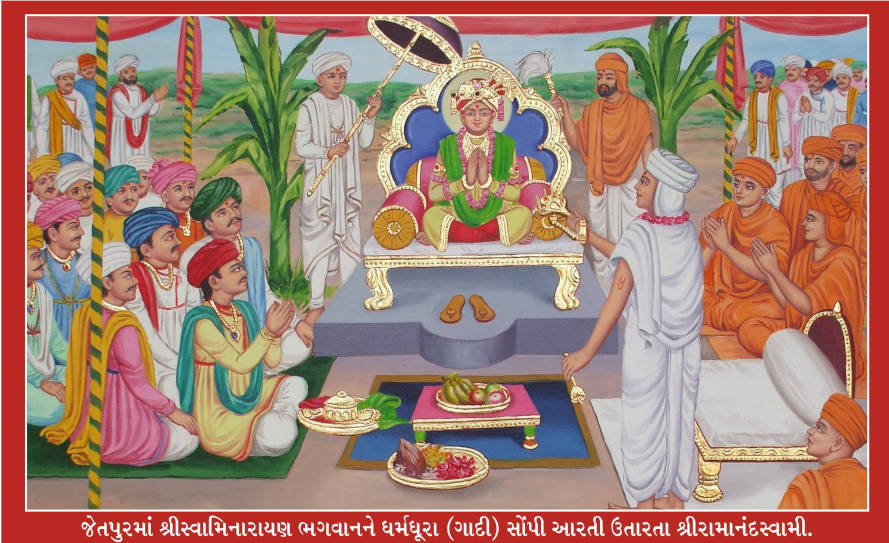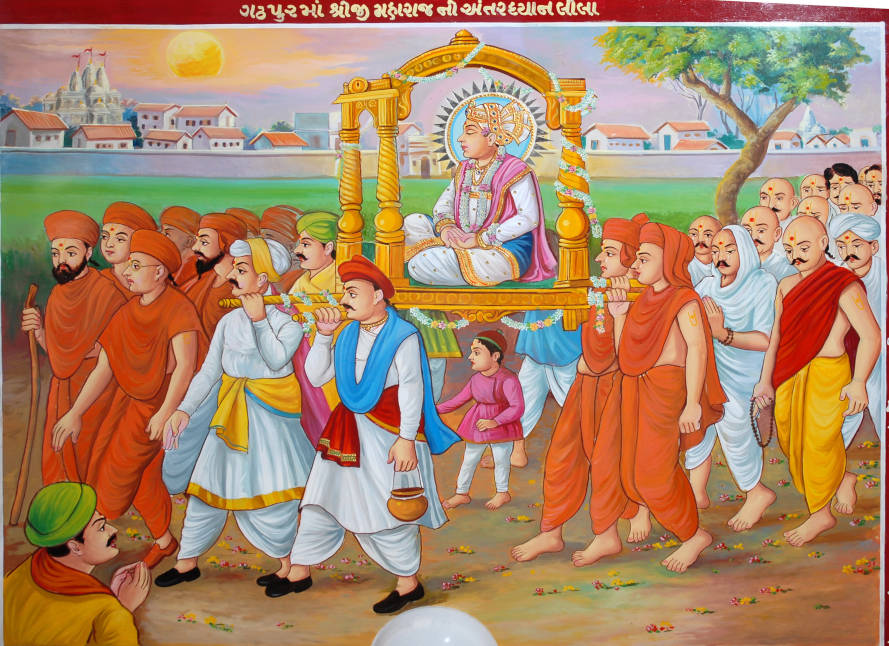Swaminarayan Bhagwan
A Brief Introduction of Lord Swaminarayan
In a world filled with those seeking spiritual fulfillment, there are countless faiths and deities being worshipped by their respective devotees. It is said that in Hinduism alone, there are roughly 33 million demigods, each with a vast following of devout disciples. Despite this magnitude of spirituality, corruption and impurity by evil persons have continually plagued religious worship throughout mankind’s history. In 1781 AD, however, devotees became unimaginably blessed. The supreme God from which each of these deities emanate—Swaminarayan Bhagwan—had finally arrived to Earth to abolish immorality and spread joy.
Many times, throughout human history, evil has intermittently run rampant threatening the welfare of good, principled people. In order to support His devotees and vanquish these threats, Swaminarayan Bhagwan had to incarnate infinite times in various capacities. Swaminarayan Bhagwan has taken many forms and identities to support devout worshippers. However, He had never visited Earth in His original, unaltered form—not until April 3rd, 1781 AD.
Vedic Evidence Behind the Swaminarayan Bhagwan:
Skeptics may question the validity of these truths and doubt the supremeness of Swaminarayan Bhagwan. However, long before His arrival, the most ancient and revered Vedic scriptures foretold of His arrival. The Skanda Purana, as compiled by Vyasa Bhagwan, foretells that Swaminarayan Bhagwan would come to this Earth during the age of Kali, between the avatars of Buddha and Kalki to protect dharma and those who follow it. It is further described in the Vasudev Mahatmya scripture that He would be born to Dharma and Bhakti as a brahmin after being cursed by Durvasa Rishi and be given the name Narayan Muni. Similar references to the legitimacy of Swaminarayan faith as a Vedic Sect can be found in Brahmanda Purana, Padma Purana, and Vishnudharmottara Purana.
Skanda Purana, Part 2 – Vasudev Mahatmya, Chapter 18, Verses 42-44:
मया कृष्णेन निहताः साङर्जुनेन रणेषु ये | प्रवर्तयिष्यन्त्यसुरांस्ते त्वधर्म यदा क्षितौ |४२| धर्मदेवात् तदा मूर्तौ नरनारायणात्मना | प्रवृत्तेङपि कलौ ब्रह्मन् भूत्वाहं सामगो द्विजः |४३| मुनिशापान्नृतां प्राप्तं सर्षिं जनकमात्मनः | ततोङविता गुरुभ्योङहं सद्धर्मं स्थापयन्नज |४४|
Maya Krushnen nihataaha Saarjunen raneshu ye|
Pravartyishyantya suraanste tva-dharm yadaa kshitau |42|
Dharmadevaat tadaa murtau Nar-Narayanaatmana|
Pravruttepi kalau brahman bhutvaaham saamago dwijah |43|
Munisha-paanrutam praptam sarshim janakmatmanaham|
Tato-vitaa gurubhyo-aham saddharmam sthaapayannaj |44|
Arjun and I (Krishna) have defeated evil demons, and I have gifted them moksha if they have died seeing Me or at My hands. Those, who died with evil intent in their hearts will be born in Kali yuga and wreak havoc. At that time, after the curse of Durvasa to Nar Narayan, I will be born in Kali yuga as a Samvedi brahmin. I will vanquish all evil and establish righteousness, while protecting all the rishis, my mother Bhakti, and my father Dharma.
Brahmanda Purana:
दत्तात्रेयः कृतयुगे त्रेतायां रघुनन्दनः | द्वापरे वासुदेवः स्यात् कलौ स्वामी वृषात्मजः ||
Dattaatreyah kruta-yuge, tretaayam Raghunandanah|
Dwaapare Vasudevah syaat kalau Swami Vrushaat-majah ||
In Sat yuga, I will be born as Dataatrey and in Treta yuga, I will be Ram. During Dwaapar yuga, I will be Krishna and in Kali yuga, I will be born and be known as God Swaminarayan.
Padma Purana:
पाखंडे बहुले लोके स्वामिनाम्ना हरिः स्वयम् | पापपङ्कनिमग्नं तज्जगदुध्धारयिष्यति ||
Paakhande bahule loke, Swami-naamna Hari-h-swayam |
Paapaknimagnam taj-jaga-dudhdhaarayishyati ||
When deception in the veiled disguise of righteousness prevails on Earth, Hari Himself will be born as ‘Swami’ and absolve the people of sin.
Vishwaksen Samhita:
भूम्यां कृतावतारोङयं सर्वानेताञ्जनानहम् | प्रापयिष्यामि वैकुंठं सहजानन्दनामतः ||
Bhumyaam krutaavataroyam, sarvaanetaajna naham |
Praapishyaami Vaikuntham Sahajanand naam-tah ||
I will take birth by the name of Sahajanand Swami and will guide My devotees to my divine abode of Vaikunth.
Vishnudharmottar Puran:
महाधर्मान्वये पुण्ये नाम्ना पापविनाशके | हरिप्रसादविप्रस्य स्वामिनाम्ना हरिः स्वयम् ||
Mahaadharmaanvaye punye naamnaa paap-vinaashake |
Hariprasad viprasya Swami naamna Hari swayam ||
All sins and wrongdoing will vanish at the chanting of My name. Hari Himself will be born to the brahmin Hariprasad Pande.
A Synopsis of Swaminarayan Bhagwan’s Accomplishments:
Perhaps the greatest evidence of the supremeness of Swaminarayan Bhagwan is the remarkable feats Swaminarayan Bhagwan accomplished during His 49 brief years on this Earth. He performed miracles on a daily basis during his childhood, renounced the material world at the young age of 11, and endured perilous hardships of nature and evil during his 7-year journey across India. Additionally, he mastered yogic principles and peak spiritual heights in a manner never previously achieved. To accomplish these feats before the age of 20 without exerting his supreme power and without using violence is evidence enough of his sarvoparita. Over the next three decades, Swaminarayan Bhagwan systematically erected a resolute sampraday that served as a safe haven for his dear saints and devotees, while enabling the spread of righteousness and devotion. He orated ethereal, complex discourses that were compiled into the greatest holy scripture Vachanamrut and penned a letter of 212 commandments (Shikshapatri) that would guide his devotees to the divine paradise of Akshardham. Every thought and action performed by Swaminarayan Bhagwan was designed for the welfare of his present and future devotees. Such is Swaminarayan Bhagwan—supreme, all-powerful, humble, and most of all, benevolent.
A Timeline Highlighting Major Events of Swaminarayan Bhagwan’s Life:
Chaitra Sud 9th, Vikram Samvat (VS) 1837:
Swaminarayan Bhagwan is born in Chhapaiya (a small village in Uttar Pradesh, India) to Dharmadev and Bhaktimata.

Ashadh Vad 7th, VS 1837:
SageMarkendey bestows Swaminarayan Bhagwan with the names Hari, Krishna, and Harikrishna during the naming ceremony held in Chhapaiya. The townspeople, however, continue to affectionately call Him Ghanshyam.

Ashadh Sud 10th, VS 1849:
Ghanshyam renounces his family and the material world, by departing home and heading into the dense forests of Northern India in search of a Guru and spiritual enlightenment. During his journey throughout India, He liberated innumerous ascetic yogis who lovingly referred to Him as Nilkanth Varni.

Shravan Vad 6th, VS 1856:
Nilkanth Varni finally arrives to Loj, Gujarat and meets the pure saints under Ramanand Swami. It was in this Loj ashram where Muktanand Swami successfully answers Nilkanth Varni’s fabled 5 spiritual questions—thus ending Nilkanth Varni’s journey of finding a worthy guru in Ramanand Swami.

Kartik Sud 11th, VS 1857:
After waiting nearly a year for Ramanand Swami to return from Bhuj, Nilkanth Varni finally met His guru in the town of Piplana on Jeth Vad 12, VS 1856. Only a few short months later, He received the ceremonial diksha and formally adopted Ramanand Swami as His guru—not because He required it, but rather to demonstrate to all devotees the rightful path to salvation. On this day, Ramanand Swami named Nilkanth Varni as Sahajanand Swami and Narayan Muni.

Kartik Sud 11th, VS 1858:
Exactly one year after becoming his disciple, Ramanand Swami handed the reins of his vast sect to 20-year old Sahajanand Swami in Faneni.

Magshar Vad 11th, VS 1858:
Shortly after the passing of Ramanand Swami, the entire sect had been stricken with deep grief. Sahajanand Swami subsequently called a vast assembly of all followers and introduced His true identity by revealing His real name—Swaminarayan. Whoever was present in the assembly that fortunate day, fell into an immediate trance after chanting “Swaminarayan.” They immediately went to Akshardham and became overwhelmed with happiness and joy.

VS 1878 – VS 1885:
During this period, Swaminarayan Bhagwan had the novel concept of erecting 6 grand temples at His own hands—Ahmedabad, Bhuj, Vadtal, Dholera, Junagadh, and Gadhpur. Each established idol held a certain significance and history that resonated with the local devotees. The devotees of Gadhpur were so enamored with Swaminarayan Bhagwan, that He gave them the central idol Gopinathji Maharaj, whose dimensions mirrored His own body measurements. Most unique of all, however, was the idol of Harikrishna Maharaj in Vadtal. Swaminarayan Bhagwan Himself proclaimed that there is no difference between this idol and My original form that resides in Akshardham.

Kartik Sud 11th, VS 1882:
With the sect blossoming in each facet, Swaminarayan Bhagwan delegated full authority to His two nephews Ayodhyaprasadji Maharaj and Raghuvirji Maharaj—under the supervision of Gopalanand Swami. By establishing the Southern and Northern diocese of the sect in His own presence, Swaminarayan Bhagwan had effectively certified a smooth transition of power. Meanwhile, Gopalanand Swami would ensure the continued spiritual growth of the sect as a whole by guiding the two aacharyas.

Maha Sud 5th, VS 1882:
Swaminarayan Bhagwan writes a Shikshapatri, addressed to each of His devotees, detailing the 212 commandments they must abide by if they want to achieve Him and Akshardham.

Jeth Sud 10th, VS 1886:
On this solemn day, Supreme Swaminarayan Bhagwan departed this Earth. Though He had foretold many saints and devotees of wanting to leave His earthly body for many months, the sorrow was truly unbearable. Those like Gopalanand Swami, however, remained resolute. Swami knew that though it may appear as if Swaminarayan Bhagwan had passed, He is omni-present and will forever remain in all devotees’ hearts.

